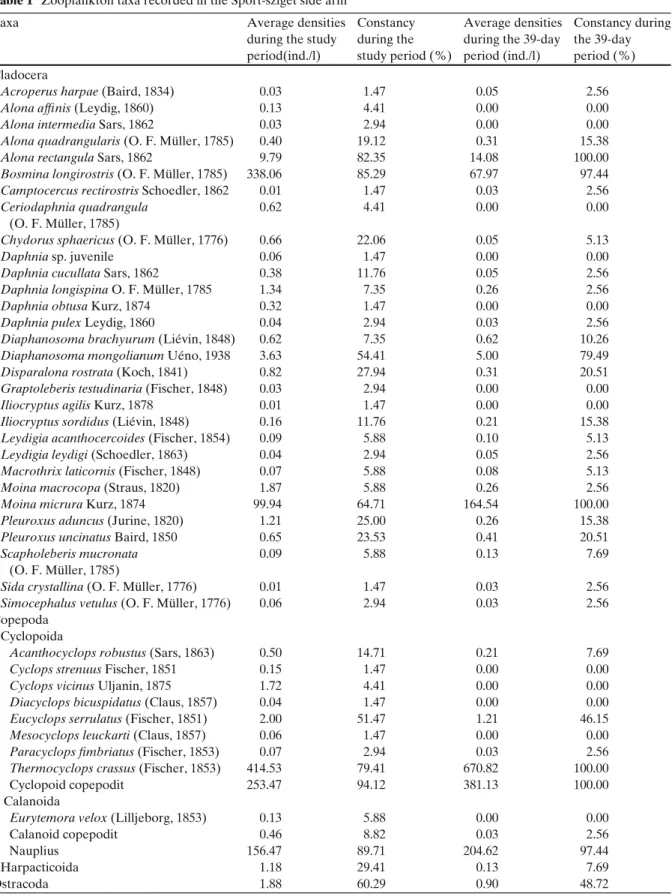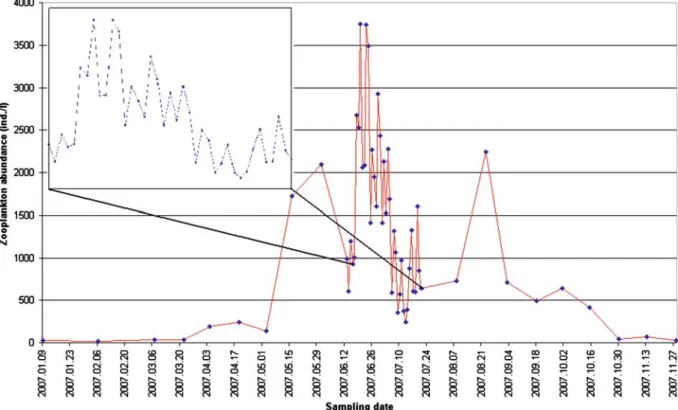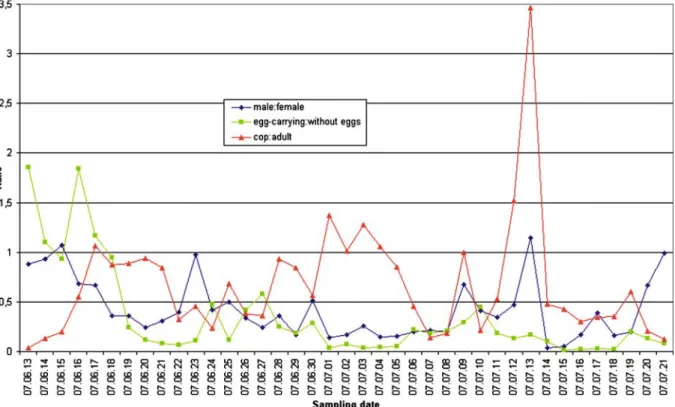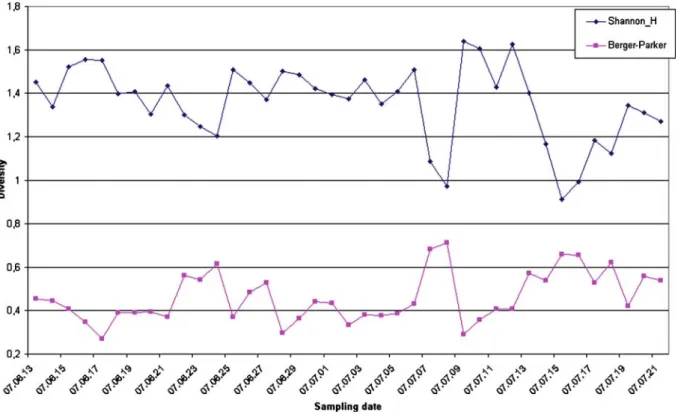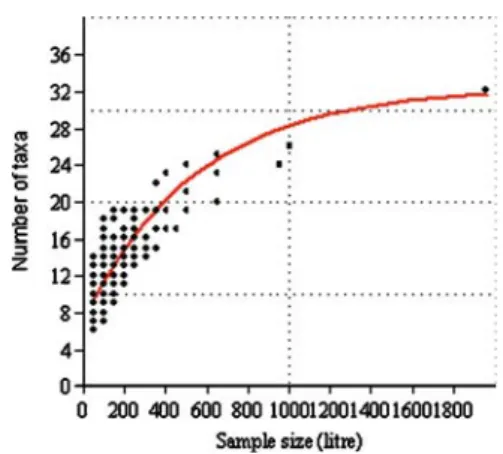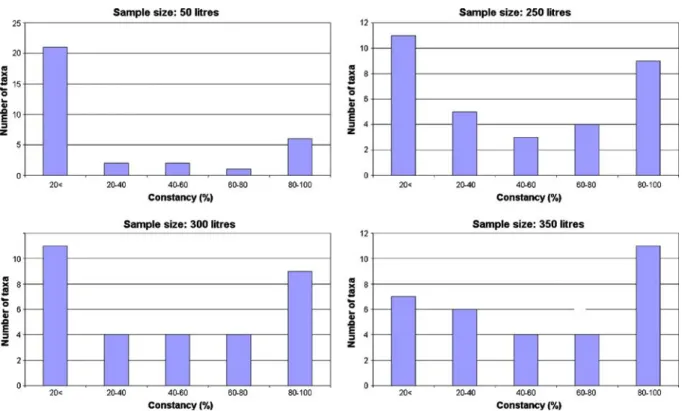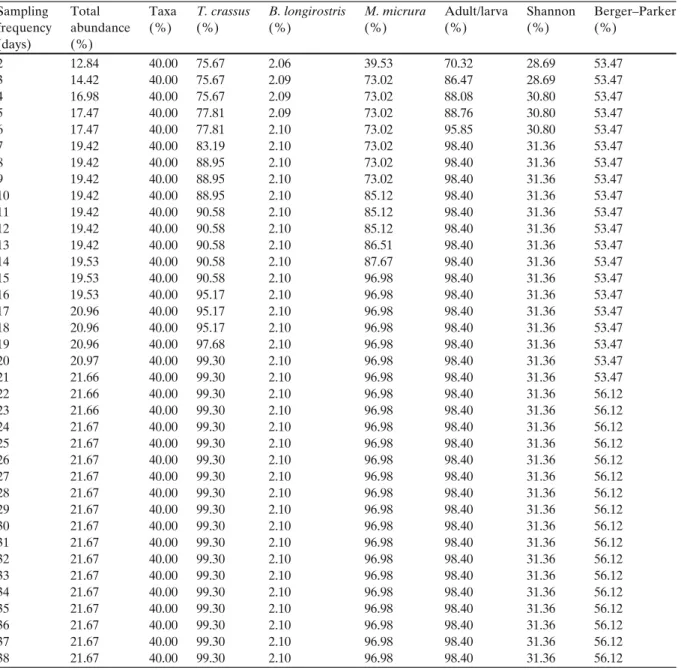DOI 10.1007/s10661-009-0822-z
Effect of sampling effort and sampling frequency on the composition of the planktonic crustacean assemblage: a case study of the river Danube
Csaba Vadadi-Fülöp·
Levente Hufnagel·Katalin Zsuga
Received: 16 September 2008 / Accepted: 2 February 2009
© Springer Science + Business Media B.V. 2009
Abstract Although numerous studies have fo- cused on the seasonal dynamics of riverine zoo- plankton, little is known about its short-term variation. In order to examine the effects of sam- pling frequency and sampling effort, microcrus- tacean samples were collected at daily intervals between 13 June and 21 July of 2007 in a para- potamal side arm of the river Danube, Hungary.
Samples were also taken at biweekly intervals from November 2006 to May 2008. After pre- senting the community dynamics, the effect of sampling effort was evaluated with two different methods; the minimal sample size was also esti- mated. We introduced a single index (potential dynamic information loss; to determine the po- tential loss of information when sampling fre- quency is reduced. The formula was calculated
C. Vadadi-Fülöp
Department of Systematic Zoology and Ecology, Eötvös Loránd University, Pázmány P. sétány 1/c, 1117 Budapest, Hungary
L. Hufnagel (
B
)Department of Mathematics and Informatics, Corvinus University of Budapest, Villányi út 29-33, 1118 Budapest, Hungary
e-mail: leventehufnagel@gmail.com K. Zsuga
Environmental and Water Research Institute (VITUKI), Kvassay út 1, 1095 Budapest, Hungary
for the total abundance, densities of the dominant taxa, adult/larva ratios of copepods and for two different diversity measures. Results suggest that abundances may experience notable fluctuations even within 1 week, as do diversities and adult/
larva ratios.
Keywords Sample size·Seasonal dynamics· Diversity·Copepoda·Cladocera
Introduction
One hinge of monitoring ecological communities is the sample-taking procedure, which has both some practical and theoretical aspects. When our objective is to explore temporal patterns in a given community, we have to face at least two prob- lems: sampling effort and sampling frequency. It is conspicuous that sampling effort influences sam- ple representativeness in some ways (Cao et al.
2002a, b; Schmera and Er ˝os 2006, 2008). There are also computer techniques, e.g. the bootstrap method (Efron1979; Efron and Tibshirani1993), which generates frequency distributions of the pa- rameter of interest, and the sampling sufficiency is achieved when the parameter reaches stability or the required level (DePatta Pillar 1998). The importance of rare species in community analy- ses is also a controversial issue. Some authors have questioned the use of rare species as they
contribute little to community dynamics and add background noise (Marchant1999; Gauch 1982);
others argued that deleting rare species can dam- age the sensitivity of methods (Cao et al. 1998).
In the simplest case, sampling effort means des- ignating the minimal sample size, which is consid- ered optimal when the potential species number is maximised. In practice, the area containing most of the species of the investigated community is refered to as the constant minimal area (Balogh 1953). One useful method for determining the constant minimal area of a community is applying the constant rule of Du Rietz et al. (1920). The Du Rietz curves describe the relationship between species number and its constancy levels. Inciden- tal species may lead to an overestimation of the species minimal area, whereas highly dominant species may lead to an underestimation of the abundance minimal area (Kronberg1987).
When determining the sampling frequency, one should take into consideration the generation time of the investigated population, which is estimated at 3–7 days by rotifers, weeks by cladocerans and months by copepods (Naidenow1998). Zooplank- ton investigations with daily frequency have been conducted poorly due to the relatively labour- intensive and time-consuming work. These studies have focused on population dynamics and pro- duction of a given species (Bothár 1987; Mavuti 1994) or elucidating possible factors controlling plankton dynamics (Ferrari et al. 1985; Zagami et al. 1996; Gulyás1987); however, little empha- sis was put on the evaluation of sampling strate- gies (Bothár1996). The diel vertical migration of zooplankton is well-documented (Cushing 1951;
Lampert1989; Bollens and Frost1991; Cuker and Watson2002), but it is based on sampling within a day, which does not contribute to our better understanding of seasonal patterns.
Although the Water Framework Directive of the European Union does not require the mon- itoring of zooplankton communities, it can still provide us with useful information inasmuch as zooplankton is regarded as a crucial component of aquatic ecosystems because of its abundance and its role in the trophic chain.
The present paper was aimed at examining the species composition and temporal patterns
of the planktonic crustacean assemblage within a 1.5-year study with special regard to a 39-day-long period when zooplankton was sampled with daily frequency. The age, sex and productivity distri- butions of the most abundant species were also determined within the 39 days. Diversity patterns were analysed with various methods (diversity indices, diversity profiles). The main purpose of this study was to detect the effect of sampling effort and sampling frequency on the compo- sition of the planktonic crustacean assemblage.
The optimal sample size was defined based on two different methods. A simple index [potential dynamic information loss (PDI)] was introduced to determine the loss of information when sam- pling frequency is reduced.
Materials and methods
Study site
The river Danube is the second largest river in Europe and is more than 2,800 km long, with a catchment area of 817,000 km2. The Ráckeve–
Soroksár Danube arm is the second largest side arm in the Hungarian section of the river Danube, and is located between 1,642 and 1,586 river kilo- metres. The study was conducted in the side arm of the Ráckeve–Soroksár Danube downstream of Budapest in the Sport-sziget side arm (47◦21 38 N, 19◦0508 E). The Sport-sziget side arm is a parapotamal type of water body; it is situ- ated in the area of Dunaharaszti. The arm length is 500 m, the width is 20–30 m and the depth is about 1–1.5 m; the water level fluctuation is negligible due to regulations. In the littoral zone, macrovegetation is formed mainly by reed; the siltation is remarkable. Although the side arm has a permanent connection to the Ráckeve–Soroksár Danube, it can be regarded as stagnant water.
The study site was designated on the basis of our objectives, which required a water body with abundant crustacean plankton within a river, and possibilities for daily sampling; what is more, it is entitled to major interest since the Ráckeve–
Soroksár Danube deserves attention, owing to its utilisations and human impact.
Table 1 Zooplankton taxa recorded in the Sport-sziget side arm
Taxa Average densities Constancy Average densities Constancy during
during the study during the during the 39-day the 39-day period(ind./l) study period (%) period (ind./l) period (%) Cladocera
Acroperus harpae (Baird, 1834) 0.03 1.47 0.05 2.56
Alona affinis (Leydig, 1860) 0.13 4.41 0.00 0.00
Alona intermedia Sars, 1862 0.03 2.94 0.00 0.00
Alona quadrangularis (O. F. Müller, 1785) 0.40 19.12 0.31 15.38
Alona rectangula Sars, 1862 9.79 82.35 14.08 100.00
Bosmina longirostris (O. F. Müller, 1785) 338.06 85.29 67.97 97.44
Camptocercus rectirostris Schoedler, 1862 0.01 1.47 0.03 2.56
Ceriodaphnia quadrangula 0.62 4.41 0.00 0.00
(O. F. Müller, 1785)
Chydorus sphaericus (O. F. Müller, 1776) 0.66 22.06 0.05 5.13
Daphnia sp. juvenile 0.06 1.47 0.00 0.00
Daphnia cucullata Sars, 1862 0.38 11.76 0.05 2.56
Daphnia longispina O. F. Müller, 1785 1.34 7.35 0.26 2.56
Daphnia obtusa Kurz, 1874 0.32 1.47 0.00 0.00
Daphnia pulex Leydig, 1860 0.04 2.94 0.03 2.56
Diaphanosoma brachyurum (Liévin, 1848) 0.62 7.35 0.62 10.26
Diaphanosoma mongolianum Uéno, 1938 3.63 54.41 5.00 79.49
Disparalona rostrata (Koch, 1841) 0.82 27.94 0.31 20.51
Graptoleberis testudinaria (Fischer, 1848) 0.03 2.94 0.00 0.00
Iliocryptus agilis Kurz, 1878 0.01 1.47 0.00 0.00
Iliocryptus sordidus (Liévin, 1848) 0.16 11.76 0.21 15.38
Leydigia acanthocercoides (Fischer, 1854) 0.09 5.88 0.10 5.13
Leydigia leydigi (Schoedler, 1863) 0.04 2.94 0.05 2.56
Macrothrix laticornis (Fischer, 1848) 0.07 5.88 0.08 5.13
Moina macrocopa (Straus, 1820) 1.87 5.88 0.26 2.56
Moina micrura Kurz, 1874 99.94 64.71 164.54 100.00
Pleuroxus aduncus (Jurine, 1820) 1.21 25.00 0.26 15.38
Pleuroxus uncinatus Baird, 1850 0.65 23.53 0.41 20.51
Scapholeberis mucronata 0.09 5.88 0.13 7.69
(O. F. Müller, 1785)
Sida crystallina (O. F. Müller, 1776) 0.01 1.47 0.03 2.56
Simocephalus vetulus (O. F. Müller, 1776) 0.06 2.94 0.03 2.56
Copepoda Cyclopoida
Acanthocyclops robustus (Sars, 1863) 0.50 14.71 0.21 7.69
Cyclops strenuus Fischer, 1851 0.15 1.47 0.00 0.00
Cyclops vicinus Uljanin, 1875 1.72 4.41 0.00 0.00
Diacyclops bicuspidatus (Claus, 1857) 0.04 1.47 0.00 0.00
Eucyclops serrulatus (Fischer, 1851) 2.00 51.47 1.21 46.15
Mesocyclops leuckarti (Claus, 1857) 0.06 1.47 0.00 0.00
Paracyclops fimbriatus (Fischer, 1853) 0.07 2.94 0.03 2.56
Thermocyclops crassus (Fischer, 1853) 414.53 79.41 670.82 100.00
Cyclopoid copepodit 253.47 94.12 381.13 100.00
Calanoida
Eurytemora velox (Lilljeborg, 1853) 0.13 5.88 0.00 0.00
Calanoid copepodit 0.46 8.82 0.03 2.56
Nauplius 156.47 89.71 204.62 97.44
Harpacticoida 1.18 29.41 0.13 7.69
Ostracoda 1.88 60.29 0.90 48.72
Sampling and data analysis
Samples were collected at biweekly intervals from November 2006 to May 2008. During the win- ter period (between December and February), zooplankton was sampled monthly. Daily samples were always taken between 13 June and 21 July of 2007 around 4 h. This 39-day-long period was selected according to the large individual num- bers of copepods and cladocerans. Samples were taken (with a 15-l bucket) from the open water;
50 l of water was filtered through a plankton net (50 μm mesh size). The material collected was preserved in situ in 4% formaldehyde solution.
In most cases, all zooplankton were identified and counted; only the samples characterised with extremely high individual numbers were split into two parts after homogenising, then one subsam- ple was counted. Nauplii were counted in 5-ml subsamples in special counting chambers after homogenisation. For the taxonomic determina- tion of the animals’ identification keys by Gulyás
and Forró (1999, 2001), Einsle (1993), Amoros (1984) and Dussart (1969) were used. Copepods and cladocerans were identified to species level;
however, copepods belonging to the suborder Harpacticoida and ostracods were only counted.
Diversity patterns were analysed with the Shannon and Berger–Parker indices, diversity profiles were used to compare the diversity of assemblages at different sampling frequencies.
Non-metric multidimensional scaling using the Euclidean distance was performed in order to explore temporal patterns within the 39 days and detect outliers. Data were standardised by the variance before creating the similarity matrix for the ordination. A single index (PDI) was intro- duced to determine the loss of information (%) when sampling frequency is reduced. It is calcu- lated with the formula: PDI =(Maximal change within day/maximal change within the study period)×100. The denominator is constant (max- imal change within 1.5 years), whereas the nu- merator can be altered according to the interest
Fig. 1 Seasonal and daily changes in the abundance of crustacean plankton in the year 2007. The diagram in the upper part of the figure refers to the daily changes in zooplankton abundance between June 13 and July 21
(1 day, 2 days, etc.). The change can refer to the change in species number, diversity or abun- dance of a given taxon. For determining the effect of sampling effort on the crustacean assemblage, the Du Rietz method (Du Rietz et al. 1920), the Bertalanffy model and linear regression were used. All data analyses were performed using the PAST program (Hammer et al.2001).
Results
Community structure, temporal and diversity patterns
A total of 38 species was detected during the study period, from which 29 were cladocerans and nine were copepods (Table 1). In addition, ostracods and Harpacticoida were also recorded and in- cluded in the analysis, but they were not identified
to species level. Species with the highest level of constancy included Alona rectangula, Bosmina longirostris, Diaphanosoma mongolianum, Moina micrura, Eucyclops serrulatus and Thermocyclops crassus. During the 39-day period, T. crassus, M. micrura and A. rectangula were absolutely con- stant. Thermocyclops crassus was the most abun- dant species both within the 39 days and within the whole study period. Moina micrura contributed up to 11.3% of the total zooplankton commu- nity, while B. longirostris and T. crassus added up to 38.3% and 46.9%, respectively, of the total density.
In the year of 2007, total zooplankton abun- dance rapidly increased in May then remained high during the summer with notable fluctuations and decreased in early autumn (Fig. 1). Abun- dance peak was observed on June 20, which can be attributed to the relatively high densities of T. crassus. The seasonal dynamics of cladoc- erans and copepods showed similar patterns;
Fig. 2 The male/female, egg-carrying females/females without eggs and copepodite/adult ratios by T. crassus between June 13 and July 21
Fig. 3 The diversity patterns between June 13 and July 21 (Shannon and Berger–Parker indices)
cladocerans peaked in May while copepods in June; however, the densities of cladocerans were relatively low during the summer and copepod densities were higher in almost every case. Daily sampling was performed between 13 June and 21 July. During this term, zooplankton densities ranged from 245 to 3,746 ind./50l. Much of the abundance was attributable to the population of T. crassus. The male/female, copepodite/adult and egg-carrying females/females without eggs ratios were also determined by T. crassus (Fig.2). The male/female ratio suggests that females domi- nated in almost every cases. Egg-carrying individ- uals occurred with high frequency in mid-June, and as for the copepodite/adult ratio, mostly adult individuals dominated; copepodites peaked in the middle of July.
The diversity patterns were explored with two different diversity indices; Shannon and Berger–
Parker diversities were calculated within the 39-day period (Fig.3). The Berger–Parker diver- sity is sensitive to the dominance of the dom- inant species. Due to the strong dominance of
T. crassus, the Berger–Parker diversity is rela- tively low, suggesting that the evenness is not large. Looking at Fig.3, the fluctuations seemed to be inverse: when the Shannon index takes the lowest values, the Berger–Parker diversity peaks and vice versa.
The similarity patterns of the 39 days are pre- sented in Fig. 4. In order to compare the diver- sities of the samples taken with daily frequency (summing up the samples within the 39-day pe- riod) and the samples taken roughly once in a month (one sample), diversity profiles were con- structed based on the findings of the ordination.
Since there are 39 samples, from which we have to choose one, it is rewarding to select the points
Fig. 4 The ordination plot of the samples collected be- tween June 13 and July 21 with the diversity profiles.
Diversity profiles represent the diversities of the samples taken with daily frequency (summing up the samples within the 39-day period) and the samples taken roughly once in a month for days 1, 9, 31 and 37
according to their ordination. Accordingly, 4 days (day 1, 9, 31 and 37) were selected from different positions for comparison with the samples col- lected at daily intervals. Diversity profiles suggest that samples taken on a daily basis are usually characterised with higher diversities; however, the curves are not always comparable, as they overlap (Fig. 4) with increasing distance from the inter- section. The high diversities of the daily samples by minor values of alpha indicate that the species number and the number of rare species are greater here as compared to the samples taken once in a month. The other end of the scale is the mea- sure of evenness with the Berger–Parker diversity, which implies that there is only a slight difference between the samples.
Effect of sampling effort
Originally, sample size (volume of the water taken out at the sampling site) was 50 l. A total of 1,950 l (50×39) of water was filtered during the 39-day period. Supposing we collect samples at 2-day intervals, we can do this in two ways depending on the first sampling date. It means 1,000 or 950 l of water, respectively, depending on the sum of samples (20 and 19 samples, respectively). At 3- day intervals, there are three possible outcomes;
finally, when we take only one sample within the 39-day period, there are 39 possible samples, each containing 50 l of water. So altogether, a total of 780 samples can be generated. Since it is a short period, the results are not affected by sea- sonal dynamics, so the individual samples can be summed. When we plot the sample size (volume of water) against the number of taxa, it will form a typical accumulation curve. We managed to fit the Bertalanffy model (Fig.5) to our data set. The results suggest that taking out 50 l of water does not permit detecting several taxa. At least 200 l of water should be filtered through the plankton net in order to detect half of the species; however, 1,000 l would be ideal (the accumulation curve becomes saturated) for detecting the majority of species (about 90%). From another point of view, taking out 1,000 l of water is the equivalent to a 20-day sampling period. If we measure the sample size at the logarithmic scale, linear regression can describe the relationship between sampling effort
Fig. 5 Relationship between sample size and num- ber of taxa. Bertalanffy equation: Number of taxa = 32.32(1−0.70797e−0.001818sample size). n=780
and number of taxa (regression equation: num- ber of taxa = −12.36+12,458 log sample size;
r2=0.82; n=780; p<0.001). Thus, instead of a logistic curve, we can describe the phenomenon in a more convenient way.
The effect of sample size can also be analysed with the rule of Du Rietz. The Du Rietz curve can be generated by plotting the five constancy levels of the species (0–20%, 20–40%, 40–60%, 60–80%, 80–100%) against the number of species (Fig. 6). The rule states that, if our sample size has reached the constant minimal area of the com- munity, the Du Rietz curve turns into a U-shape, meaning that the relative contribution of the con- stant and accidental species increases while the number of accessory species remains low. The curve will become asymmetrical with the highest values at lower constancy levels when the constant minimal area is not reached, as the number of absolute constant species remains low. Similarly, after going beyond the constant minimal area, the number of accidental species may increase appreciably, resulting in an asymmetrical curve with maximum values at a higher degree of con- stancy. Our results suggest that taking out 300 l of water is sufficient for achieving the constant minimal area (i.e. minimal sample size). Fifty liters of water (sample size used in the present study) does not represent the constant minimal area, as the number of constant species is low, whereas accidental species hit larger values. Taking out 350 l of water will lead to an asymmetrical curve
Fig. 6 Relationship between constancy levels and number of taxa in case of 50, 250, 300 and 350 l of water as sample size (Du Rietz curves)
with large numbers of constant species, meaning that the constant minimal area has been overesti- mated. Figure6shows the transitional features of the Du Rietz curves taking the applied sample size (50 l) as the starting point.
Effect of sampling frequency
A single index (PDI) was introduced to deter- mine the loss of information (%) when sampling frequency is reduced. The formula measures the potential loss of information depending on the sampling frequency. It was calculated for the to- tal abundance of zooplankton, number of taxa and densities of T. crassus, B. longirostris and M. micrura, moreover, for the adult/larva ratio of copepods and for the Shannon and Berger–
Parker indices. The loss of information refers to the loss in the estimation of the above-mentioned variables when sampling frequency is reduced.
Table2presents the PDI index at daily sampling frequencies (based on the calculations for the 39-day period), whereas Table 3 shows the in-
formation loss at biweekly sampling frequencies (based on the calculations for the whole study period, excluding samples taken on the daily basis). Results suggest that there are large differ- ences between species, namely T. crassus densities change rapidly, whereas B. longirostris densities varied slightly (∼2%) within the 39 days. It means that the individual numbers of T. crassus expe- rienced large fluctuations in the 39-day period (75.67% variation within 1 day as compared to the change within one and a half year of the study period). As a consequence, 75.67% potential information is lost when samples are taken at a 2-day frequency. However, looking at Table 3, B. longirostris densities showed large variation within 2 weeks (95.94%), which is due to the fact that the population peak (15,730 ind./50 l) was not observed within the 39 days (population peak: 330 ind./50 l) but in May 2008. Thus, it is conspicuous that the PDI index indicates minor variation at daily frequency with a maximum of 2.10% variation as compared with the whole study period. Therefore, it seemed evident to present
Table 2 The values of the PDI index (%) at daily sampling frequencies
Sampling Total Taxa T. crassus B. longirostris M. micrura Adult/larva Shannon Berger–Parker
frequency abundance (%) (%) (%) (%) (%) (%) (%)
(days) (%)
2 12.84 40.00 75.67 2.06 39.53 70.32 28.69 53.47
3 14.42 40.00 75.67 2.09 73.02 86.47 28.69 53.47
4 16.98 40.00 75.67 2.09 73.02 88.08 30.80 53.47
5 17.47 40.00 77.81 2.09 73.02 88.76 30.80 53.47
6 17.47 40.00 77.81 2.10 73.02 95.85 30.80 53.47
7 19.42 40.00 83.19 2.10 73.02 98.40 31.36 53.47
8 19.42 40.00 88.95 2.10 73.02 98.40 31.36 53.47
9 19.42 40.00 88.95 2.10 73.02 98.40 31.36 53.47
10 19.42 40.00 88.95 2.10 85.12 98.40 31.36 53.47
11 19.42 40.00 90.58 2.10 85.12 98.40 31.36 53.47
12 19.42 40.00 90.58 2.10 85.12 98.40 31.36 53.47
13 19.42 40.00 90.58 2.10 86.51 98.40 31.36 53.47
14 19.53 40.00 90.58 2.10 87.67 98.40 31.36 53.47
15 19.53 40.00 90.58 2.10 96.98 98.40 31.36 53.47
16 19.53 40.00 95.17 2.10 96.98 98.40 31.36 53.47
17 20.96 40.00 95.17 2.10 96.98 98.40 31.36 53.47
18 20.96 40.00 95.17 2.10 96.98 98.40 31.36 53.47
19 20.96 40.00 97.68 2.10 96.98 98.40 31.36 53.47
20 20.97 40.00 99.30 2.10 96.98 98.40 31.36 53.47
21 21.66 40.00 99.30 2.10 96.98 98.40 31.36 53.47
22 21.66 40.00 99.30 2.10 96.98 98.40 31.36 56.12
23 21.66 40.00 99.30 2.10 96.98 98.40 31.36 56.12
24 21.67 40.00 99.30 2.10 96.98 98.40 31.36 56.12
25 21.67 40.00 99.30 2.10 96.98 98.40 31.36 56.12
26 21.67 40.00 99.30 2.10 96.98 98.40 31.36 56.12
27 21.67 40.00 99.30 2.10 96.98 98.40 31.36 56.12
28 21.67 40.00 99.30 2.10 96.98 98.40 31.36 56.12
29 21.67 40.00 99.30 2.10 96.98 98.40 31.36 56.12
30 21.67 40.00 99.30 2.10 96.98 98.40 31.36 56.12
31 21.67 40.00 99.30 2.10 96.98 98.40 31.36 56.12
32 21.67 40.00 99.30 2.10 96.98 98.40 31.36 56.12
33 21.67 40.00 99.30 2.10 96.98 98.40 31.36 56.12
34 21.67 40.00 99.30 2.10 96.98 98.40 31.36 56.12
35 21.67 40.00 99.30 2.10 96.98 98.40 31.36 56.12
36 21.67 40.00 99.30 2.10 96.98 98.40 31.36 56.12
37 21.67 40.00 99.30 2.10 96.98 98.40 31.36 56.12
38 21.67 40.00 99.30 2.10 96.98 98.40 31.36 56.12
Table 3 The values of the PDI index (%) at biweekly sampling frequencies
Sampling Total Taxa T. crassus B. longirostris M. micrura Adult/larva Shannon Berger–Parker
frequency abundance (%) (%) (%) (%) (%) (%) (%)
(weeks) (%)
2 93.19 40.00 77.10 95.94 76.07 74.48 68.56 73.21
4 98.96 55.00 84.61 99.93 76.07 95.29 95.35 100.00
6 99.26 70.00 86.77 99.99 100.00 95.29 100.00 100.00
8 99.71 85.00 96.95 99.99 100.00 98.44 100.00 100.00
10 100.00 100.00 100.00 100.00 100.00 98.44 100.00 100.00
12 100.00 100.00 100.00 100.00 100.00 98.44 100.00 100.00
14 100.00 100.00 100.00 100.00 100.00 100.00 100.00 100.00
the results in two different aspects (Tables 2 and3). Similarly, the adult/larva ratio of copepods implied larger fluctuations within the 39-day term, but it is not true for the diversity indices. The Shannon and Berger–Parker indices showed large variation within 2 weeks (Table 3). Considering all variables, 14 weeks (∼3 months) proved to be enough to achieve the 100% variation within the whole study period. However, the densities of T. crassus, M. micrura and the adult/larva ratio of copepods displayed major variations (above 90%) within 2 weeks (Table 2). The variations in the number of taxa were constant (40%) within the 39 days and reached the 100% limit at 10 weeks.
Total zooplankton abundance varied moderately within the 39 days but showed major variation (93.19%) within 2 weeks in the whole study period, which can be originated in the population peak of B. longirostris.
Discussion
Our results pointed out that sampling effort and sampling frequency can have a significant impact on the monitoring of the planktonic crustacean assemblage at least within the framework of the present case study.
Diversity patterns proved to be one useful tool for describing the zooplankton community struc- ture. The inverse fluctuations of the Shannon and Berger–Parker indices can be attributed to the sensibility of measures. Berger–Parker index is relatively sensitive to the evenness, whereas the Shannon index considers the species number rather important. When the Berger–Parker index takes large values, the abundance of the dominant species (T. crassus) is low indicating relatively large evenness; however, it does not mean large species number definitely. The examined water body was not species-poor but it was strongly dominated by one species (T. crassus); thus, cal- culating the Berger–Parker index seemed to be relevant. Diversity profiles indicated that samples taken on a daily basis can be characterised by higher diversities, particularly regarding species richness. However, the results are not always comparable due to the overlapping curves. This suggests that, as for the evenness, there are only
minor differences between samples taken at daily frequency and those of once in a month.
The effect of sampling effort was tested with two different methods. The minimal sample size resulted in 1,000 and 300 l of water, respectively.
This sample size is beyond those applied in the studies of riverine plankton: 10 l (Illyová 2006), 20 l (De Ruyter Van Steveninck et al. 1990), 25 l (Vranovsky1991), 30 l (Saunders and Lewis 1989), 40 l (Reckendorfer et al.1999), 50 l (Gulyás 1995), 60 l (Ietswaart et al. 1999), 100 l (Gulyás 1994; Maria-Heleni et al. 2000) and 200 l (V.- Balogh et al.1994; Bothár1988; Bothár and Kiss 1990). Obviously, taking 1,000 l of water would mean an enormous effort, and this should not be the desired goal. We have seen that taking out such a large volume of water will represent about 90% of the species; however, we do not need to detect 90% of the species in one sample definitely.
The results are based on 39 days, which is not capable of detecting seasonal patterns. Taking out 50 l of water in winter is not the equivalent of a 50-l plankton sample taken in summer. The latter would contain far more species because sea- sonality influences taxa composition. The lowest number of taxa (one species) was detected in the beginning of March, whereas the highest number was 21 taxa in May. During the 39-day period, the number of taxa ranged between six and 14.
The seasonal changes in zooplankton species com- position are well-documented in rivers as well (Kim and Joo2000; Kobayashi et al.1998; Maria- Heleni et al. 2000; Illyová 2006; Tubbing et al.
1994). Thus, many species could not be registered in the present case study because of the short- term observation. This being the case, our results should be handled watchfully.
The Du Rietz rule was tested exactly only for homogeneous plant associations with low spe- cies number. In heterogeneous associations with high species richness, the Du Rietz curve can be skewed (Balogh 1953). According to the present work, the Du Rietz curve has taken the U-shape, more or less proving that it can be used for such communities. The rule can only be applied for taxa with minor variations in size within a definite order of magnitude. This assumption is fulfiled in case of planktonic crustaceans. Our results sug- gested that some 300 l of water represents the
constant minimal area (i.e. minimal sample size) of the crustacean plankton in the Sport-sziget side arm. However, we should not forget that the size of the minimal area is subject to seasonal and regional variations (Kronberg1987).
Generally, seasonal dynamics of riverine zoo- plankton have been discussed on the basis of samples collected at biweekly (Kim and Joo2000;
Maria-Heleni et al. 2000; Reckendorfer et al.
1999) or weekly intervals (Bothár 1988; Bothár and Kiss 1990; V.-Balogh et al. 1994). Bothár (1996) performed zooplankton investigations in the river Danube on the daily basis and pointed out that no regular quantitative change or fluctuation in zooplankton abundance can be observed, although phytoplankton and water chemical data showed regular daily patterns.
Copepods showed 2–3-day periodicities, which was attributable to the structural changes of dif- ferent developmental stages. The author con- sidered the weekly sampling strategy as an adequate tool to get a clear picture of the spe- cies composition and quantitative changes of zoo- plankton in the river Danube. Our results (PDI index) indicate that abundances may experience notable fluctuations even within 1 week, as do diversities and adult/larva ratios. According to the findings within the 1.5-year study period, samples taken at biweekly frequencies are not always sufficient (PDI for total abundance is 93% within 2 weeks). This is partly due to the relatively short generation time of cladocerans.
The present study is only confined to planktonic crustaceans; however, rotifers are characterised with shorter generation times (Akopian et al.
2002; Lair2006) and they are often the dominant component of riverine zooplankton (Gulyás 1995—Danube River; Burger et al. 2002—
Waikato River; Kim and Joo 2000—Nakdong River; Maria-Heleni et al. 2000—Aliakmon River; Saunders and Lewis 1988—Apure River;
Saunders and Lewis 1989—Orinoco River; Van Dijk and Van Zanten1995—Rhine River; Thorp et al. 1994—Ohio River). Therefore, additional research is needed when sampling strategies of zooplankton can be evaluated.
In summary, we demonstrated within the framework of a case study in the river Danube
that the quantitative and qualitative compositions of the zooplankton samples are strongly influ- enced by sampling effort and sampling frequency.
The findings should be handled watchfully, but they can serve as a basis for future research.
References
Akopian, M., Garnier, J., & Pourriot, R. (2002). Ciné- tique du zooplancton dans un continuum aquatique:
De la Marne et son réservoir a l’ estuaire de la Seine. Comptes Rendus Biologies, 325, 807–818.
doi:10.1016/S1631-0691(02)01483-X.
Amoros, C. (1984). Crustacés cladocères, Introduction pra- tique a la systématique des organismes des eaux con- tinentales francaises. Bulletin Mensuel de la Societe Linneenne de Lyon, 53, 1–63.
Balogh, J. (1953). A zoocönológia alapjai – Grundzüge der Zoocönologie. Budapest: Akadémiai Kiadó.
Bollens, S. M., & Frost, B. W. (1991). Diel vertical mi- gration in zooplankton: Rapid individual responses to predators. Journal of Plankton Research, 13, 1359–
1365. doi:10.1093/plankt/13.6.1359.
Bothár, A. (1987). Produktionsschätzung von Acanthocy- clops robustus (G. O. Sars) in der Donau (26, pp. 339–
343). Arbeitstagung der IAD, Passau/Deutschland, Wissenschaftliche Kurzreferate.
Bothár, A. (1988). Results of long-term zooplankton inves- tigations in the River Danube, Hungary. Verhandlung Internationale Vereinigung Limnologie, 23, 1340–1343.
Bothár, A. (1996). Die lang-und kurzfristigen Änderun- gen in der Gestaltung des Zooplanktons (Cladocera, Copepoda) der Donau - Probeentnahmestrategien (31, pp. 201–206). Arbeitstagung der IAD, Baja/Ungarn, Wissenschaftliche Referate.
Bothár, A., & Kiss, K. T. (1990). Phytoplankton and zooplankton (Cladocera, Copepoda) relationship in the eutrophicated river Danube (Danubialia Hungarica, CXI). Hydrobiologia, 191, 165–171.
doi:10.1007/BF00026050.
Burger, D. F., Hogg, I. D., & Green, J. D. (2002).
Distribution and abundance of zooplankton in the Waikato River, New Zealand. Hydrobiologia, 479, 31–
38. doi:10.1023/A:1021064111587.
Cao, Y., Williams, D. D., & Williams, N. E. (1998). How important are rare species in aquatic community ecol- ogy and bioassessment? Limnology and Oceanogra- phy, 43, 1403–1409.
Cao, Y., Larsen, D. P., Hughes, R. M., Angermeier, P. L.,
& Patton, T. M. (2002a). Sampling effort affects mul- tivariate comparisons of stream assemblages. Journal of the North American Benthological Society, 21, 701–
714. doi:10.2307/1468440.
Cao, Y., Williams, D. D., & Larsen, D. P. (2002b). Compar- ison of ecological communities: The problem of sam- ple representativeness. Ecological Monographs, 72, 41–56.
Cuker, B. E., & Watson, M. A. (2002). Diel vertical mi- gration of zooplankton in contrasting habitats of the Chesapeake Bay. Estuaries, 25, 296–307. doi:10.1007/
BF02691317.
Cushing, D. H. (1951). The vertical migration of plank- tonic Crustacea. Biological Reviews of the Cambridge Philosophical Society, 26, 158–192. doi:10.1111/j.1469- 185X.1951.tb00645.x.
DePatta Pillar, V. (1998). Sampling sufficiency in ecologi- cal surveys. Abstracta Botanica, 22, 37–48.
De Ruyter Van Steveninck, E. D., Van Zanten, B.,
& Admiraal, W. (1990). Phases in the develop- ment of riverine plankton: Examples from the rivers Rhine and Meuse. Hydrological Bulletin, 24, 47–55.
doi:10.1007/BF02256748.
Du Rietz, G. E., Fries, T. C. E., Oswald, H., & Tengwall, Y. A. (1920). Gesetze der Konstitution natürlicher Pflanzengesellschaften. Flora Fauna, 7, 1–47.
Dussart, B. (1969). Les Copepodes des Eaux Continentales II: Cyclopoides et Biologie. Ed. N. Boubee & Cie, Paris.
Efron, B. (1979). Bootsrap methods: Another look at the jackknife. Annals of Statistics, 7, 1–25. doi:10.1214/
aos/1176344552.
Efron, B., & Tibshirani, R. (1993). An introduction to the bootsrap. London: Chapman & Hall.
Einsle, U. (1993). Crustacea, copepoda: Calanoida und cyclopoida. In J. Schwoerbel & P. Zwick (Ed.), Süsswasserfauna von Mitteleuropa, Bd. 8, Heft 4, Teil 1 (pp. 1–208). Stuttgart: Gustav Fischer Verlag.
Ferrari, I., Cantarelli, M. T., Mazzocchi, M. G., & Tosi, L. (1985). Analysis of a 24-hour cycle of zooplankton sampling in a lagoon of the Po River Delta. Journal of Plankton Research, 7, 849–865. doi:10.1093/plankt/
7.6.849.
Gauch, H. G. (1982). Multivariate analysis in community ecology. Cambridge: Cambridge University Press.
Gulyás, P. (1987). Tägliche Zooplankton-Untersuchungen im Donau-Nebenarm bei Ásványráró im Sommer 1985 (26, pp. 123–126.) Arbeitstagung der IAD, Passau/Deutschland, Wissenschaftliche Kurzreferate.
Gulyás, P. (1994). Studies on the Rotatorian and Crus- tacean plankton in the Hungarian section of the Danube between 1848,4 and 1659,0 riv. km. In R.
Kinzelbach (Ed.), Biologie der Donau (pp. 49–61).
Stuttgart: Gustav Fischer Verlag.
Gulyás, P. (1995). Rotatoria and Crustacea plankton of the River Danube between Bratislava and Budapest.
Miscellanea Zoologica Hungarica, 10, 7–19.
Gulyás, P., & Forró, L. (1999). Az ágascsápú rákok (Cladocera) kishatározója, 2. b ˝ovített kiadás. Vízi Természet- és Környezetvédelem, 9. kötet. Budapest:
Környezetgazdálkodási Intézet.
Gulyás, P., & Forró, L. (2001). Az evez ˝olábú rákok (Calanoida és Cyclopoida) alrendjeinek kishatározója, 2. b ˝ovített kiadás. Vízi Természet- és Környezetvédelem, 14. kötet. Budapest: Környezetgazdálkodási Intézet.
Hammer, O., Harper, D. A. T., & Ryan, P. D. (2001).
PAST: Paleontological Statistics software package for education and data analysis. Palaeontologia Electron- ica, 4(1), 1–9.
Ietswaart, T. H., Breebaart, L., Van Zanten, B., &
Bijkerk, R. (1999). Plankton dynamics in the river Rhine during downstream transport as influenced by biotic interactions and hydrological conditions. Hydro- biologia, 410, 1–10. doi:10.1023/A:1003801110365.
Illyová, M. (2006). Zooplankton of two arms in the Morava River floodplain in Slovakia. Biologia, 61, 531–539.
doi:10.2478/s11756-006-0087-8.
Kim, H. W., & Joo, G. J. (2000). The longitudinal distribu- tion and community dynamics of zooplankton in a reg- ulated large river: A case study of the Nakdong River (Korea). Hydrobiologia, 438, 171–184. doi:10.1023/
A:1004185216043.
Kobayashi, T., Shiel, R. J., Gibbs, P., & Dixon, P. I.
(1998). Freshwater zooplankton in the Hawkesbury–
Nepean River: Comparison of community struc- ture with other rivers. Hydrobiologia, 377, 133–145.
doi:10.1023/A:1003240511366.
Kronberg, I. (1987). Accuracy of species and abundance minimal areas determined by similarity area curves.
Marine Biology (Berlin), 96, 555–561. doi:10.1007/
BF00397974.
Lair, N. (2006). A review of regulation mechanisms of metazoan plankton in riverine ecosystems: Aquatic habitat versus biota. River Research and Applications, 22, 567–593. doi:10.1002/rra.923.
Lampert, W. (1989). The adaptive significance of diel ver- tical migration of zooplankton. Functional Ecology, 3, 21–27. doi:10.2307/2389671.
Marchant, R. (1999). How important are rare species in aquatic ecology and bioassessment? A comment to conclusions of Cao et al. 1999. Limnology and Oceanography, 44, 1840–1841.
Maria-Heleni, Z., Michaloudi, E., Bobori, D. C., &
Mourelatos, S. (2000). Zooplankton abundance in the Aliakmon River, Greece. Belgian Journal of Zoology, 130, 29–33.
Mavuti, K. M. (1994). Durations of development and production estimates by two crustacean zooplankton species Thermocyclops oblongatus Sars (Copepoda) and Diaphanosoma excisum Sars (Cladocera) in Lake Naivasha, Kenya. Hydrobiologia, 272, 185–200.
doi:10.1007/BF00006520.
Naidenow, W. (1998). Das Zooplankton der Donau. In E. Kusel-Fetzmann, W. Naidenow, & B. Russev (Eds.), Plankton und Benthos der Donau, Ergebnisse der Donau-Forschung, Band 4 (pp. 163–248). Wien: Inter- nationale Arbeitsgemeinschaft Donauforschung.
Reckendorfer, W., Keckeis, H., Winkler, G., & Schiemer, F. (1999). Zooplankton abundance in the River Danube, Austria: The significance of inshore reten- tion. Freshwater Biology, 41, 583–591. doi:10.1046/
j.1365-2427.1999.00412.x.
Saunders, J. F., & Lewis, W. M. (1988). Zooplank- ton abundance and transport in a tropical white- water river. Hydrobiologia, 162, 147–155. doi:10.1007/
BF00014537.
Saunders, J. F., & Lewis, W. M. (1989). Zooplankton abundance in the lower Orinoco River, Venezuela.
Limnology and Oceanography, 34, 397–409.
Schmera, D., & Er ˝os, T. (2006). Estimating sample rep- resentativeness in a survey of stream caddisfly fauna.
Annales de Limnologie - International. Journal of Limnology, 42, 181–187.
Schmera, D., & Er ˝os, T. (2008). A mintavételi er ˝ofeszítés hatása a mintareprezentativitásra. Acta Biologica Debrecina Supplementum Oecologica Hungarica, 18, 209–213.
Thorp, J. H., Black, A. R., Haag, K. H., & Wehr, J. D. (1994). Zooplankton assemblages in the Ohio River: Seasonal, tributary, and navigation dam effects.
Canadian Journal of Fisheries and Aquatic Sciences, 51, 1634–1643. doi:10.1139/f94-164.
Tubbing, D. G. M. J., Admiraal, W., Backhaus, D., Friedrich, G., Van Steveninck, E. D. D., Muller, D., et al. (1994). Results of an international plankton investigation on the River Rhine. Water Science and Technology, 29, 9–19.
Van Dijk, G. M., & Van Zanten, B. (1995). Seasonal changes in zooplankton abundance in the lower Rhine during 1987–1991. Hydrobiologia, 304, 29–38.
doi:10.1007/BF02530701.
V.-Balogh, K., Bothár, A., Kiss, K. T., & Vörös, L.
(1994). Bacterio-, phyto- and zooplankton of the River Danube (Hungary). Verhandlung Internationale Vereinigung Limnologie, 25, 1692–1694.
Vranovsky, M. (1991). Zooplankton of a Danube side arm under regulated ichthyocoenosis conditions.
Verhandlung Internationale Vereinigung Limnologie, 24, 2505–2508.
Zagami, G., Badalamenti, F., Guglielmo, L., & Manganaro, A. (1996). Short-term variations of the zooplankton community near the straits of Messina (North-eastern Sicily): Relationships with the hydrodynamic regime.
Estuarine, Coastal and Shelf Science, 42, 667–681.
doi:10.1006/ecss.1996.0043.
